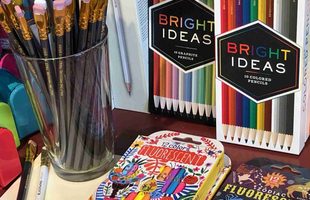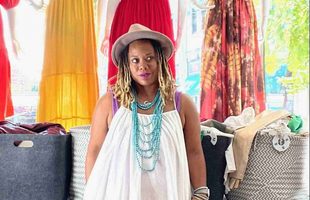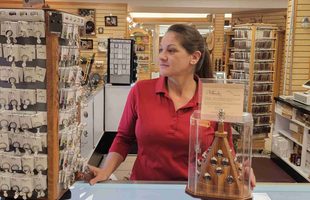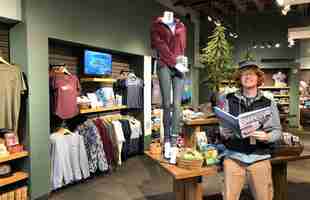By Karen Appold
 Apparel in elegant cabinetry at Wilderness at the Smokies. Crew neck and standard cut T-shirts sell best in the attraction’s stores.
Apparel in elegant cabinetry at Wilderness at the Smokies. Crew neck and standard cut T-shirts sell best in the attraction’s stores.Many people already have a lot of T-shirts in their wardrobe. So how can you entice them to buy one more when they visit your gift shop?
First and foremost, you should offer what’s tried and true. Some styles have withstood the test of time—such as crew necks.
For Kathie Henry, retail director, Wilderness at the Smokies, Sevierville, Tenn., crew neck and standard cut T-shirts sell best in her stores. “Both men and women can wear most of the styles,” she said.
Likewise Matt Blumhardt, vice president, Holiday World & Splashin’ Safari, Santa Claus, Ind., said crew neck T-shirts are definitely his best-seller. “We primarily sell T-shirt as souvenirs; a crew neck basic tee captures a large audience,” he said.
Emily Simmons, director of resort management and retail operations, Wilderness Resort, Wisconsin Dells, Wis., has also found that crew necks sell the best, particularly ones that are lightweight with a smaller graphic. “Guests are looking for something comfortable and affordable,” she said.
Similar sentiments were expressed by Jennifer Vance, assistant retail manager/buyer, Timber Ridge Lodge & Waterpark, Lake Geneva, Wis. At her shop, basic styles and regular necklines sell best at the 900-square-foot shop. “They are universal; everyone can wear them,” she said.
Another way to get customers to buy T-shirts is to sell a new look. This is one way to ensure that shoppers won’t already own a bunch of tees just like it already.
Shonee Strother, retail manager, Luna Park in Coney Island, Brooklyn, N.Y., said, “We revised our apparel line for the 2019 season to make it more fashion forward and on trend. As a native New Yorker, streetwear has always been a driver of fashion for me, and now that the trend is truly catching up and more people of all ages are embracing the culture, we wanted to make sure that we were positioned to have a foothold in the market.”
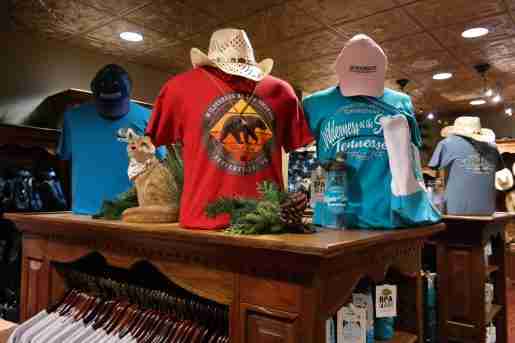 An accessory, gift and apparel display at Wilderness at the Smokies, Sevierville, Tenn. The staff stresses friendliness, respect and courtesy when dealing with the public.
An accessory, gift and apparel display at Wilderness at the Smokies, Sevierville, Tenn. The staff stresses friendliness, respect and courtesy when dealing with the public.Strother takes pride in representing Brooklyn’s historical contributions to style and trend as honestly as possible. “At the core of planning, we keep decision making questions in mind such as, ‘Why does someone buy a piece of apparel?’ and the resounding answer was ‘because they saw something cool they wanted in their closet.’” Park apparel shouldn’t be any different. What’s better than a guest wearing a piece of your park as a memory and having someone walk up to them and say ‘Cool shirt! Where did you get it?’ ”
Offer Trendy Colors
Popular colors vary among stores. Currently, Henry said, heather, coral, mint, pink and any variation of blue are all the rage. “These colors look good on most skin tones,” she said.
Tie dye continues to be Blumhardt’s number one-selling color scheme. Pastels have sold well in recent years as well.
Tie dye designs also rule at Wilderness Resort. “Guests enjoy the diversity of the bright colors,” she said.
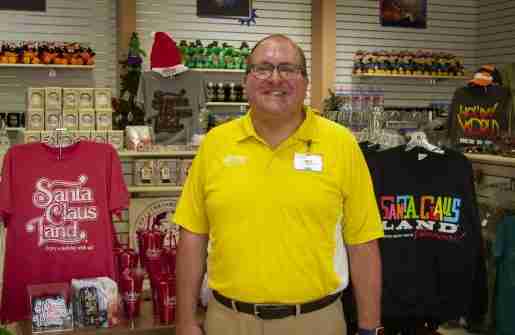 Matt Blumhardt with Santa Claus Land merchandise. Blumhardt, who is vice president for Holiday World & Splashin’ Safari in Santa Claus, Ind., said crew neck T-shirts are best-sellers.
Matt Blumhardt with Santa Claus Land merchandise. Blumhardt, who is vice president for Holiday World & Splashin’ Safari in Santa Claus, Ind., said crew neck T-shirts are best-sellers.Go the Extra Mile
Providing excellent customer service can go a long way in securing sales. Henry said the shop’s retail associates introduce themselves to guests when they enter the store and ask how they might assist them. “We stress friendliness, respect and courtesy for achieving guest satisfaction,” she said. “Our team is familiar with our products and they readily suggest either a replacement if we do not have exactly what the guest is asking for or they will suggest an alternative source for purchasing on our property.”
Furthermore, Henry said they maintain a list of products that guests request. They add these products to their inventory.
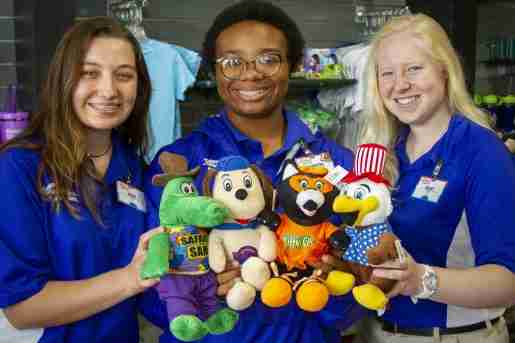 Team members, from right to left, Kerri Stewart, Shadira Chester and Hailey Thayer, of Holiday World & Splashin’ Safari, photographed with plush toys. Limited edition T-shirts are doing well for the attraction.
Team members, from right to left, Kerri Stewart, Shadira Chester and Hailey Thayer, of Holiday World & Splashin’ Safari, photographed with plush toys. Limited edition T-shirts are doing well for the attraction.Staff at Holiday World & Splashin’ Safari have implemented a successful promotional T-shirt program and are particularly good at upselling. “Guests that spend a minimum of $25 before tax on merchandise become eligible to purchase a limited edition dated T-shirt for only $9.99,” Blumhardt said. “This strategy has dramatically increased our overall T-shirt volume and encourages additional spending at the point of purchase.”
Employees are encouraged to wear the resort’s product, Simmons said. This helps guests to visualize what the product would look like when wearing it. “We encourage staff to be friendly and make conversation with guests, and help them find what they are looking for,” she said.
Strother said that his team is knowledgeable and on trend. “We keep up with what’s selling well, and keep the floor looking fresh by rotating displays bi-weekly and highlighting what’s doing well that week on our feature wall.” His staff also wears the shop’s apparel in store, which helps them explain to shoppers how sizes run and what size to get.
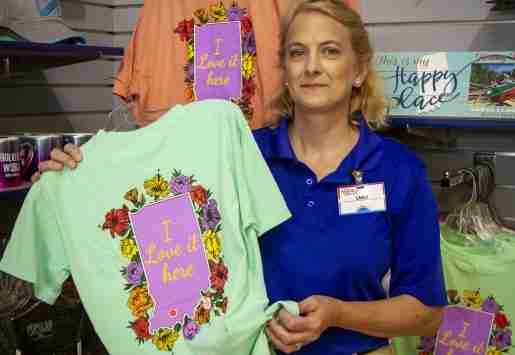 Team Member Lana Anderson of Holiday World & Splashin’ Safari in Santa Claus, Ind. A promotional T-shirt program has been
Team Member Lana Anderson of Holiday World & Splashin’ Safari in Santa Claus, Ind. A promotional T-shirt program has beensuccessful at the attraction, according to the vice president.
Other Ways to Boost Sales
Henry recommended re-setting displays periodically and stocking fresh, eye-catching designs to increase sales. Year over year revenues are increasing 12 to 18 percent through effective cross merchandising and innovative product selection.
In a theme park environment, Blumhardt said that it’s key to bring the nostalgia and the brand of the park to life in the form of merchandise. In recent years, most parks have introduced retro or vintage lines of apparel. “I would strongly recommend developing apparel featuring a retro park logo, throwback marketing slogan or a defunct attraction,” he said.
Simmons keeps some staple products on hand, and she also tries out new products often to see what will work best for guests. The attraction has four stores onsite, with the largest being 836 square feet.
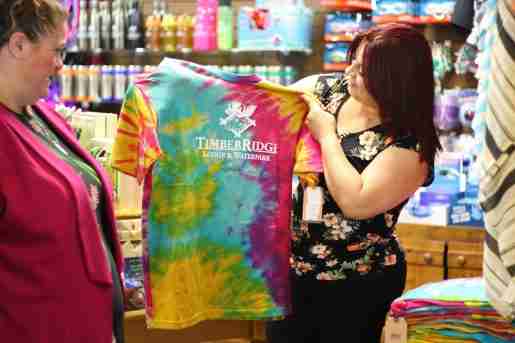 A woman holding up a T-shirt as Jennifer Vance, assistant retail manager/buyer with Timber Ridge Lodge & Waterpark in Lake Geneva, Wis., looks on. Basic T-shirt styles sell best for the attraction.
A woman holding up a T-shirt as Jennifer Vance, assistant retail manager/buyer with Timber Ridge Lodge & Waterpark in Lake Geneva, Wis., looks on. Basic T-shirt styles sell best for the attraction.“People who visit Luna Park in Coney Island come in all shapes and sizes, so it is especially important to make sure the store is able to accommodate all body types,” Strother said. “Not everyone who visits a park is there to ride a ride, some folks are there to create memories. When someone buys souvenir apparel, they’re purchasing a memory or a moment in time. It should be something they want to recall every time they put it on.”
Displaying Shirts for Sure Sales
T-shirt Selling Strategies
By Karen Appold
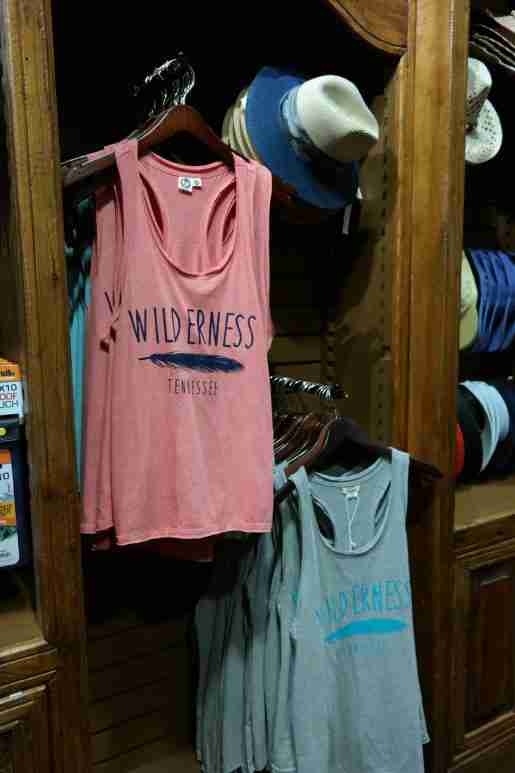 Sleeveless T-shirts in pastel colors at Wilderness at the Smokies, Sevierville, Tenn. Cross merchandising displays works well for the attraction, according to the retail director.
Sleeveless T-shirts in pastel colors at Wilderness at the Smokies, Sevierville, Tenn. Cross merchandising displays works well for the attraction, according to the retail director.Most customers will glance around a gift shop until something really catches their eye. So how can your T-shirt displays command a second look?
Kathie Henry, retail director, Wilderness at the Smokies, Sevierville, Tenn., has found that cross merchandising displays works well. For example, if a guest is primarily looking for a tote, a matching T-shirt displayed with the tote will catch their eye. “We purchase complementary colors so our T-shirts can be displayed separately or together, creating a pleasing aesthetic and continuity in our shops,” she said.
Holiday World & Splashin’ Safari in Santa Claus, Ind., creates art programs that work across apparel and hard lines. “Displays that incorporate matching and complementary items help to draw customers in and generate impulse purchases of smaller items,” said Matt Blumhardt, vice president. For example, they might display a shirt design alongside headwear and a handbag that match it.
Emily Simmons, director of resort management and retail operations, Wilderness Resort, Wisconsin Dells, Wis., uses mannequins to display shirts. “We often pair shirts with a similar sweatshirt or accessory to catch the eye,” she said.
Jennifer Vance, assistant retail manager/buyer, Timber Ridge Lodge & Waterpark, Lake Geneva, Wis., advised folding T-shirts nicely as well as having some face outward when hanging them.
Shonee Strother, retail manager, Luna Park in Coney Island, Brooklyn, N.Y., believes that apparel can speak for itself and that a shop should fade into the background. “Apparel is the star of the show and a shop is its well-designed stage,” he said. “Part of driving the idea of a successful apparel display is the idea that when guests walk into your shop, they’re walking out of the park and into a retail clothing establishment. This helps remove the idea that they’re just buying something because that’s simply something you do when you’re visiting a park and starts to get them invested in buying a piece of apparel that they actually want and can have forever.”
